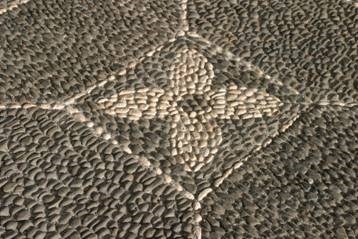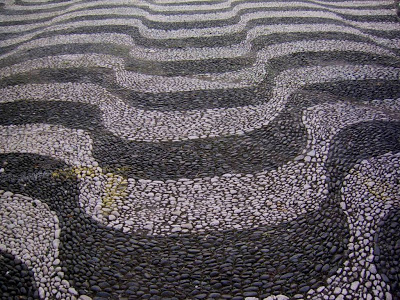Tratuários
PT


Na Calçada Madeirense são aplicados seixos e calhaus de rochas vulcânicas e carbonatadas, recolhidas em depósitos de praias e fluviais da Ilha da Madeira e Porto Santo.
A população local designa vulgarmente a pedra aplicada na calçada madeirense por seixo ou calhau ou cascalho rolado. Estas diferenças de designações estão intimamente relacionadas com a dimensão do grão.
A escala granulo-métrica de Wentworth, permite estabelecer os limites dos tamanhos das partículas constituintes dos sedimentos. Deste modo, os calhaus estão inseridos na classe granulo-métrica compreendida entre os 256mm e os 64mm e os seixos na classe compreendida entre os 64mm e os 4mm.
Os seixos e calhaus de rochas vulcânicas apresentam-se lisos, polidos e arredondados. A cor escura que exibem, normalmente é devido à patine que vão adquirindo ao longo do tempo por efeito da poluição e da sujidade.
Nas rochas vulcânicas destacam-se entre os principais tipos litológicos, os traquiandesitos, os traquibasaltos, os traquitos, os basaltos e os hawaiites, cuja tonalidade varia desde o cinzento claro até à cor negra.
No caso das rochas carbonatadas, estas são representadas por calcários recifais marinhos e a cor varia entre o branco leitoso, ao castanho amarelado até ao castanho avermelhado.
As propriedades físico-mecânicas dos principais tipos de pedra natural utilizados na calçada madeirense que foram avaliadas no Instituto Nacional de Engenharia, Tecnologia e Inovação (INETI) no Porto permitem concluir que a rocha traquibasáltica é a que apresenta menos desgaste, 0.6mm, e que o calcário recifal é aquela que apresenta maior desgaste, 4.2mm.
Esta earthcache é um tributo a uma arte quase desaparecida e que em tempos tornou o Funchal n’ “Uma cidade cheia de praias” (frase proferida numa palestra sobre o tema pelo Professor Doutor Engenheiro João Batista Pereira Silva) atendendo ao número elevadíssimo de calhaus e seixos utilizados no calcetamento das ruas da cidade e para puderes fazer o log desta Earthcache responde às seguintes questões:
-
No chão deste jardim e segundo a escala granulo-métrica de Wentworth, identifica se está presente calhaus ou seixos.
-
Quais os tipo de pedra calcetados neste passeio.
-
Descreve o formato das pedras e a sua superfície desta calçada.
-
A patine que algumas pedras foram adquirindo ao longo do tempo, é por efeito de que factores.
Não é necessário esperar pela autorização do owner da earthcache para registar como encontrada.
Depois de enviares o email com as respostas, podes registar como encontrada.
Se o email com as respostas não for recebido ou estas estiverem incorrectas, o registo será apagado sem qualquer aviso prévio.
ENG


In Madeiran pavement are applied pebbles and boulders of volcanic and carbonated rocks collected in deposits of beaches and inland streams of Madeira and Porto Santo.
Local people commonly refers to the stone applied in Madeira sidewalk or pebble by pebble or rolled gravel. These differences designations are closely related to the grain size.
The granule-metric Wentworth scale, allows to establish the limits of the size of the constituent particles of sediment. Thus, the stones are inserted into the granule-metric class of between 256mm and 64mm and pebbles in the class of between 4mm and 64mm.
Pebbles and boulders of volcanic rocks show up smooth, polished and rounded. The dark color display is typically due to the patina they acquire over time due to the effect of pollution and contamination.
In volcanic rocks stand out among the main rock types, the trachyandesites, the trachybasalts, the trachytes, basalts and hawaiites, whose tone varies from light gray to black.
In the case of carbonate rocks, these are represented by marine reef limestones and the color ranges from milky white to yellowish brown to the reddish brown.
The physical and mechanical properties of the main types of natural stone used in Madeira sidewalk were evaluated at the National Institute of Engineering, Technology and Innovation (INETI) in Oporto can allow the conclusion that the traqui basaltic rock is the one with less wear, 0.6mm, and the reef limestone is one that has greater wear, 4.2mm.
This EarthCache is a tribute to an almost vanished art and that once became Funchal as '"A city full of beaches" (sentence uttered during a lecture on the subject by Professor João Batista Pereira Silva Engineer) given the high number of pebbles and cobbles used in pavement the city streets and to log this EarthCache you will have to answer the following questions:
-
On this garden’s ground and according to the granule-metric scale Wentworth, identify if these are stones or pebbles.
-
What types of stones are in this tour.
-
Describe the shape of the stone and its surface present on this sidewalk.
-
The patina that some stones have acquired over time, is the result of witch factors.
You do not have to wait for the owner’s authorization to log this EarthCache. Once you send the email with the answers, you can register as found. If the email with the answers is not received or they are incorrect, the log will be deleted without any notice.